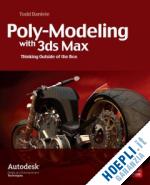Polymodeling with MaxBook Outline-Chapters1. Introduction- What this book is all about, as well as a brief overview of the authors credentials2. Modeling Types- We are going to cover all of the modeling options, as some will lend themselves later to the polymodeling process.Splines- NurbsPatchBoxPolymodeling: an intro to our preferred method of modeling- Features covered will include spline modeling, surface modifier basics. Creating a base mesh we can later apply polymodeling techniques to.-A brief discussion of the Nurbs modeling toolset and functions.-Patch modeling tools, usage and conversion to an editable poly mesh. We will build a basic mesh and convert so we can apply polymodeling techniques. -Basic Box modeling overview with a focus on the tools and techniques commonly used. Extrude, inset, bevel, chamfer tools will be introduced and demonstrated. As before we can use this mesh as a base for polymodeling techniques.-Polymodeling: an intro to our preferred method of modeling. A brief discussion on this technique, and the benefits of its use.3. Polymodeling Basics-Techniques used to add detail to a model, various methods to move sub-object selections with precision.-Editable poly- Shift/Drag method will be introduced and demonstrated. Shift drag will be the basis of many of our model building exercises later on in the book. -edge and face constraints, usage and benefits. The constraint systems are a key element to our polymodeling workflow later on. -Inset, bevel, chamfer, bridge to create and form our model.-Sub-object Selection methods, conversion techniques to speed workflow. -edit poly modifier4. Modifiers-Letting Max do the work for you------Information, as well as a demonstration of how allowing the application to do calculations can often result in a cleaner end product.-Bend Modifier, Taper, Spherify and other applicable object-space modifiers. A demonstration of how these modifiers will produce cleaner meshes. We will later model a detailed object in a flat state and use a modifier to give it a curved surface.5. Derivative modeling and other techniques to speed up your polymodeling workflow--- We are going to cover the method of extracting part of a mesh to build another mesh, using repetitive geometry, and using the info from the last chapter to alter an existing model into something unique.-Detach element, detach polygons to create additional geometry from existing models.-edge constraints to shape and fine tune the new object-Shell Modifier to create depth and thickness to our models-Snap tools to align sub-object elements to existing meshes.6. Theory and application--Not a very technical description, we are just going to discuss what works, and why it works, without getting involved in any information that may be confusing.-Edge loops, what they are and why they are good-Vertex proximity, how vertex placement influences the detailed areas of our models.-Sub-object placement-positioning and manipulation of all sub-object elements-mesh flow, directing a mesh flow through the use of polymodeling tools7. You are in Control-Your mesh shouldn't dictate your final output- We are going to cover some common polymodeling mistakes, and the simple, and not so simple solutions to them.-Welding vertices to create smooth corners and transitions-Pinching and correction, steps to eliminate common mesh errors -mesh, loop and vertex density8. Preparation-Tips to make your projects go smoother- Basic overview of references, applications, blueprints and other aspects that aid in the process.-Reference collection, and resources. Where to find refs, how to prepare them for optimal usage later on.-Setting up blueprints, mapping images to planes that are used as a guide for polymodeling.-Spline guides, we are going to show the benefits of using splines to map out your meshflow-Image manipulation with an image editor for better result when modeling.(changes to saturation, color and size)-Using ACDSee/settings to efficiently view reference while modeling.9. Hard-Edge Modeling- A step by step excercise in hard edge modeling(man made objects). We are going to cover some material that will have the reader producing clean, professional results.-Tutorial using all of the tools mentioned earlier. Vertex and edge placement, and density, as well as constraints will be covered.-techniques to implement, and when to use them10. Organic/Soft-edge modelling-- Step by step excercise covering important aspects of Organic modeling. We will touch on creating an animation ready mesh.-Tutorial using all of the tools mentioned earlier Vertex and edge placement, and density, as well as constraints will be covered. We will also show proper mesh flow and how to create an animatable mesh.-techniques to implement, and when to use them-Edge loops and deformation11. Mixing it up- Crossing boundries between soft and hard edge modelling.---Information about the use of 2 very different modeling disciplines to benefit each other in the creative process.-Crossing of techniques to create more natural results.12. LOD(level of detail) for production - Enough is Enough-- An overview of what is required in a deadline environment. We always want to add more detail, many times deadline dictates what we can actually do. Tricks and tips to get the best results with time limitations.-Modeling for a deadline13. Non modeled Geometric detail-Bump and Displacement mapping-- We are going to cover the growing importance of displacement, and bump maps to add non modeled detail to your models. We will discuss pros and cons of each, and when to use each 1.-how to prep a model for export to 1 of theses apps(basic steps.) -UV unwrapping is involved, this is a bit of a tedious process, so everydetail will not be covered-Basic overview of what 1 would typically do in z-brush/mudbox.Painting details, subdividing meshes-Export of displacement maps (a map that gives the illusion that yourmodel has much more modeled detail)-Finally we will reimport the model/maps, and show how to set-up 3dsMaxto show the result of the work done in the external application14. Scripts, Plug-ins and other additions-- A basic overview of some scripts and tools that make modeling even more user friendly within 3DS Max.-Polyboost- Basic overview and usage-OrionFlame-Basic overview and usage15. Final word












